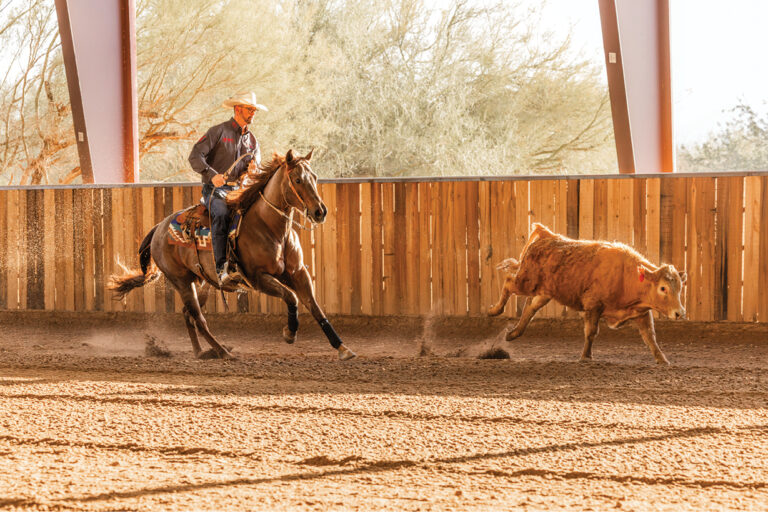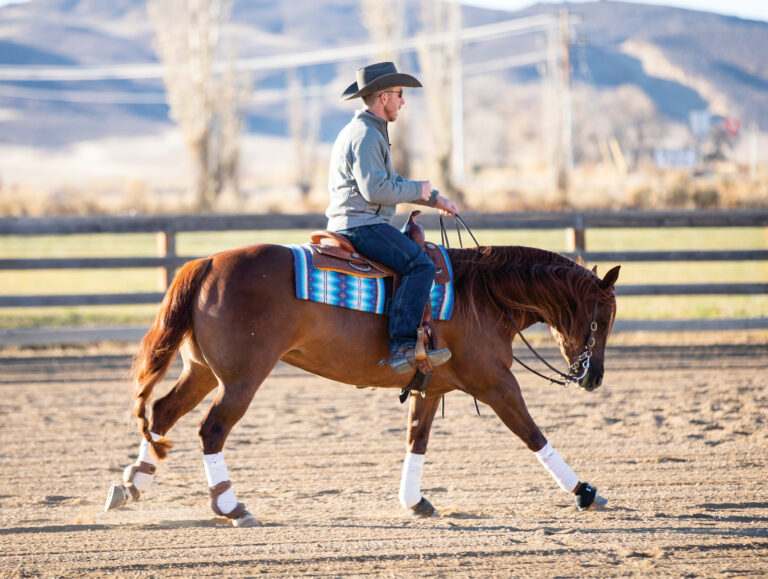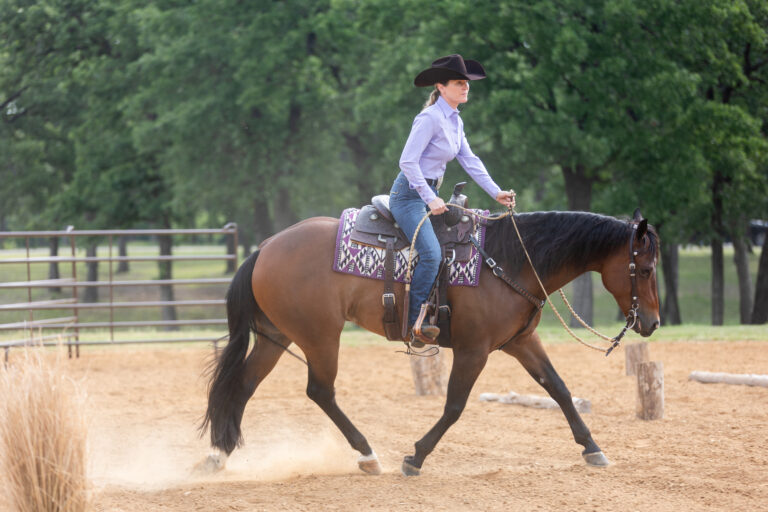LESSON PLAN
Your instructor: Shawn Flarida of Springfield, Ohio.

Lesson’s objective: To teach you basics that will enable you to develop a soft, slow, effective reining hand (when riding your reining horse—or any horse—one-handed in a bridle with a curb bit).
Why you need this: Your reins are a key point of communication with your horse. Correct use of your reining hand not only enables your horse to understand what you’re asking of him, but also encourages him to give you a smooth, willing response.
If you want “soft and smooth” from your horse, then you must give him soft and smooth with your reining hand. To do that, you must sit correctly in the saddle, balanced and relaxed, and think in terms of using your hand slowly.
If your hand is fast and jerky, your horse will be rough and jerky. He’ll brace with his body, raise his head (possibly even flip it), and gape his mouth.
A jerky hand is often the result of a poorly positioned body. I’m going to show you how to sit correctly in the saddle, so you can begin to work to develop the soft hand that’s essential in reining or any discipline. Proper positioning and good balance give you an independent hand that can provide just exactly the degree of pressure you need, in the direction you choose, all while staying light and smooth.
Work with a trainer or a knowledgeable friend on the ground as you practice what I describe in this lesson. He or she can tell you if you’re sitting properly and keeping your hand soft—and slow.
BODY POSITION:
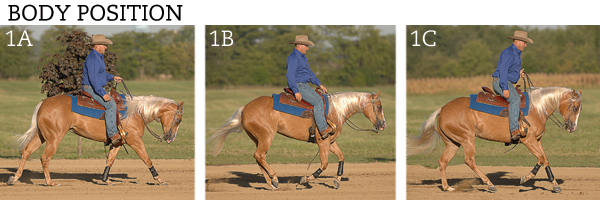
1a. To be able to use your rein hand freely and correctly, sit correctly in the saddle, with your shoulders over your hips, and your weight sinking naturally into your heels. Your rein hand should be above your horse’s withers (here I’m softening my mare’s jaw a bit, so my hand is slightly higher than it would ordinarily be). Hold your other hand naturally, comfortably at your side. The correct position in the saddle will enable you to stay relaxed, which encourages your horse to relax, as well. Look how soft and pretty my mare is here, and in the opening photo, above.
1b. Don’t sit back too far and jam your feet forward, as I am here. This is a chair seat that will inhibit you from staying with your horse’s movement, which in turn will keep you from maintaining consistent control of your rein hand—in other words, you’ll be jerky.
1c. Don’t sit like this, either. Tipped forward in this manner, your upper body is invading the space you want free for your rein hand. Plus you’ll get ahead of your horse’s movement, creating tension in your body and his, and you’ll have a tendency to look down, as I am here.
HAND POSITION TURNING…
…TO LEFT:
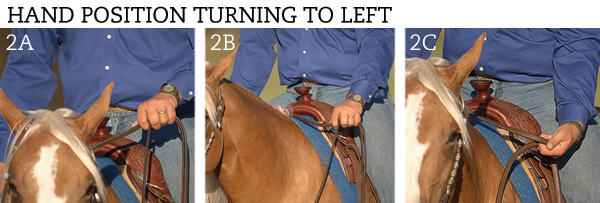
2a. Your rein hand should grasp the reins softly, with your index finger between the two reins for precise feel and control. For a turn to the left, carry your hand slightly toward your left hip, at about the height of your hip, by bending at the elbow and drawing your hand slowly and smoothly.
2b. Don’t lower your hand to initiate the turn, as I am here. This exaggerates the feel of the rein across your horse’s neck, which sets him up for an abrupt response.
2c. Don’t rotate your wrist out and down, which causes you to stiffen your entire arm, including your elbow. You can’t ask softly with an arm like this.
…TO RIGHT:
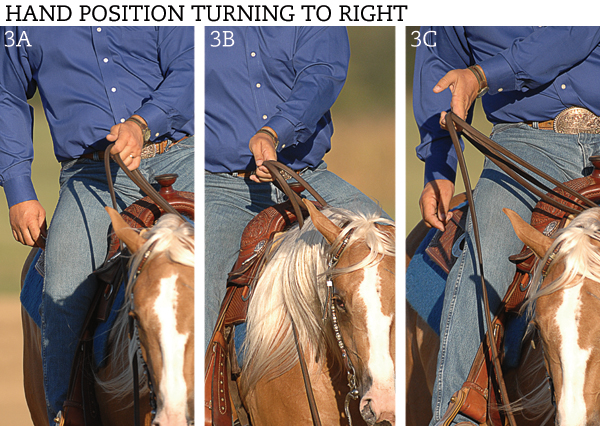
3a.To initiate a turn to the right, simply carry your rein hand slightly up and to the right, as I am here, to create a soft turn-right cue.
3b.Don’t break at the wrist, which destroys a subtle feel of the reins, or…
3c. …carry your hand way over, which exaggerates the cue and prompts too much bend (or a head toss).
TAKING A FEEL:
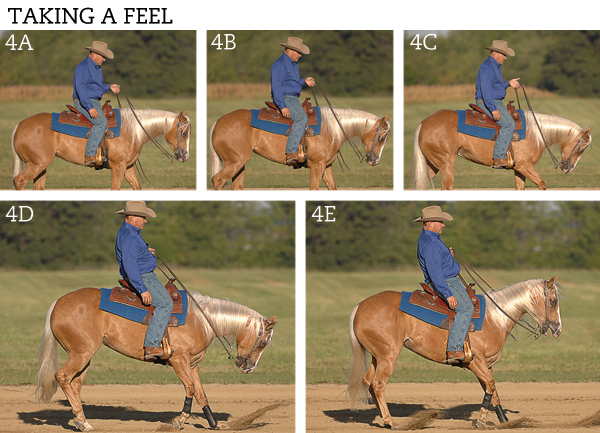
4a. Practice softness in how you take a feel of your horse’s mouth. Here, I’ve begun to ask my mare to come back to me (soften at the jaw), but note the slight drape in the reins, which indicates the softest possible contact. As my mare begins to respond…
4b. ..I maintain that light feel, moving my hand only slightly and keeping my fingers soft.
4c. As she comes back to me completely, note that there’s still not tightness in the rein. I’m keeping that feel of her mouth soft and consistent.
4d. Don’t “take a feel” like this, which is too much, too fast, too demanding, and results in…
4e. …a raised head, a gaping mouth, and bracing/stiffness in my mare’s body. Remember—if you’re not soft, your horse can’t be, either.
STOP:
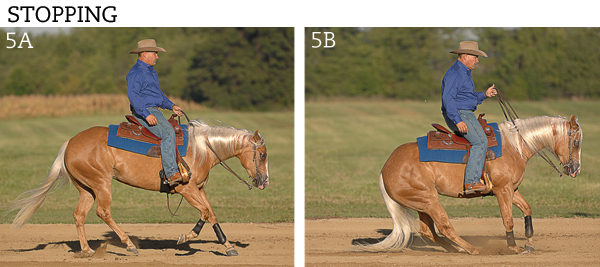
5a. Maintain softness when you’re asking for a stop. A good reining horse is trained to stop at “whoa,” so minimal rein pressure is needed. Yet so often you see riders using too much rein hand; this destroys the soft, smooth response they’re after. Here, just before I ask for the stop, my reins are light…
5b. …and here, as my horse is stopping, my reins are still light. In return, my horse’s body is relaxed and round through the topline, she’s flexing at the poll, her jaw is soft, and her mouth is closed.

